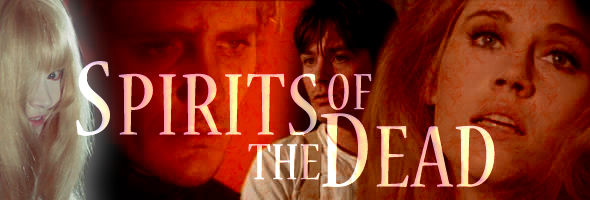
Color, 1968, 121m.
Directed by Roger Vadim, Louis Malle, and Federico Fellini
Starring Terence Stamp, Jane Fonda, Alain Delon, Brigitte Bardot, Peter Fonda
Arrow (Blu-Ray & DVD) (UK R0 HD/PAL), Home Vision (US R1 NTSC) / WS (1.78:1) (16:9)

Color, 1968, 121m.
Directed by Roger Vadim, Louis Malle, and Federico Fellini
Starring Terence Stamp, Jane Fonda, Alain Delon, Brigitte Bardot, Peter Fonda
Arrow (Blu-Ray & DVD) (UK R0 HD/PAL), Home Vision (US R1 NTSC) / WS (1.78:1) (16:9)
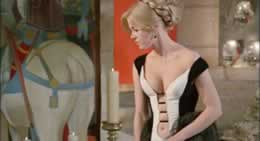 The idea of doing an anthology film consisting of Edgar Allan Poe stories was certainly not a new idea by 1968, the year audiences saw a fascinating but extremely divisive film called Spirits of the Dead, shown in Europe under a variety of titles like Tales of Mystery and Imagination, Histoires extraordinaries, and Tre passi nel delirio. Roger Corman had brought Poe to the big screen in high style with his flamboyant films (usually starring Vincent Price) including the three-story omnibus Tales of Terror, while short form Poe films had been around since the dawn of film. However, the big twist here was using three famous European filmmakers to give the project an arthouse slant, as anthologies had also become a popular method of allowing prominent filmmakers to dabble in short subjects revolving around a common theme. Titles like Six in Paris, RoGoPaG, and The Witches essentially became calling cards by which casual viewers could try out a variety of directors like Pasolini, Visconti, and Godard; of this batch, the most influential and respected was probably Boccaccio '70, which was highlighted by a Federico Fellini segment involving a giant Anita Ekberg. By the time Spirits of the Dead rolled around, a number of directors had been considered including Orson Welles (who even wrote a segment conflating "The Masque of the Red Death" and "The Cask of Amontillado"); Fellini was a natural choice, as he was riding high on the success of 8 1/2, La Dolce Vita, and his magnificent first full feature in color, Juliet of the Spirits. Meanwhile, Louis Malle was a tad more scandalous thanks to the trailblazing The Lovers a decade earlier as well as films like Elevator to the Gallows and the vibrant Viva Maria! with Brigitte Bardot. So far, so good. However, the choice of the third director, Roger Vadim (who had already contributed to the anthology film The Seven Deadly Sins), turned out to be the most controversial of the bunch. He had just finished shooting Barbarella, his third film with wife Jane Fonda (after The Game Is Over and Circle of Love), and interestingly, he was the only one of the trio with a horror film already under his belt, the superb Blood and Roses. By the time the film opened, the critical brickbats came out against Malle and particularly Vadim's segment, while Fellini's was lionized as an instant classic that could easily stand alone as its own film. While the Fellini segment is indeed an undisputed masterpiece and perhaps the finest short horror film in cinema history, the film as a whole offers considerable rewards as well if one is willing to calibrate their expectations a bit and doesn't expect much Poe apart from the story titles and a few character names.
The idea of doing an anthology film consisting of Edgar Allan Poe stories was certainly not a new idea by 1968, the year audiences saw a fascinating but extremely divisive film called Spirits of the Dead, shown in Europe under a variety of titles like Tales of Mystery and Imagination, Histoires extraordinaries, and Tre passi nel delirio. Roger Corman had brought Poe to the big screen in high style with his flamboyant films (usually starring Vincent Price) including the three-story omnibus Tales of Terror, while short form Poe films had been around since the dawn of film. However, the big twist here was using three famous European filmmakers to give the project an arthouse slant, as anthologies had also become a popular method of allowing prominent filmmakers to dabble in short subjects revolving around a common theme. Titles like Six in Paris, RoGoPaG, and The Witches essentially became calling cards by which casual viewers could try out a variety of directors like Pasolini, Visconti, and Godard; of this batch, the most influential and respected was probably Boccaccio '70, which was highlighted by a Federico Fellini segment involving a giant Anita Ekberg. By the time Spirits of the Dead rolled around, a number of directors had been considered including Orson Welles (who even wrote a segment conflating "The Masque of the Red Death" and "The Cask of Amontillado"); Fellini was a natural choice, as he was riding high on the success of 8 1/2, La Dolce Vita, and his magnificent first full feature in color, Juliet of the Spirits. Meanwhile, Louis Malle was a tad more scandalous thanks to the trailblazing The Lovers a decade earlier as well as films like Elevator to the Gallows and the vibrant Viva Maria! with Brigitte Bardot. So far, so good. However, the choice of the third director, Roger Vadim (who had already contributed to the anthology film The Seven Deadly Sins), turned out to be the most controversial of the bunch. He had just finished shooting Barbarella, his third film with wife Jane Fonda (after The Game Is Over and Circle of Love), and interestingly, he was the only one of the trio with a horror film already under his belt, the superb Blood and Roses. By the time the film opened, the critical brickbats came out against Malle and particularly Vadim's segment, while Fellini's was lionized as an instant classic that could easily stand alone as its own film. While the Fellini segment is indeed an undisputed masterpiece and perhaps the finest short horror film in cinema history, the film as a whole offers considerable rewards as well if one is willing to calibrate their expectations a bit and doesn't expect much Poe apart from the story titles and a few character names.
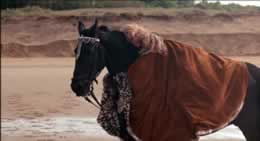 Story one, Vadim's "Metzengerstein," stars Fonda as Countess Frederique (or Federica, depending on the print you see), a cruel and capricious brat who collects people as sexual playthings in her idyllic castle where her daily games often turn deadly. One day she meets her new neighbor, Wilhelm (played by her brother, Peter Fonda), who spurns her advances anstd has no desire to join her "menagerie." In a huff, she burns down his horse stable and accidentally kills Wilhelm while he's trying to save his prize stallion, and afterwards, Frederique becomes obsessed with one of her tapestries depicting a black horse in battle... which also mysteriously burns. Then a black horse shows up on her property, and her detachment from reality begins...
Story one, Vadim's "Metzengerstein," stars Fonda as Countess Frederique (or Federica, depending on the print you see), a cruel and capricious brat who collects people as sexual playthings in her idyllic castle where her daily games often turn deadly. One day she meets her new neighbor, Wilhelm (played by her brother, Peter Fonda), who spurns her advances anstd has no desire to join her "menagerie." In a huff, she burns down his horse stable and accidentally kills Wilhelm while he's trying to save his prize stallion, and afterwards, Frederique becomes obsessed with one of her tapestries depicting a black horse in battle... which also mysteriously burns. Then a black horse shows up on her property, and her detachment from reality begins...
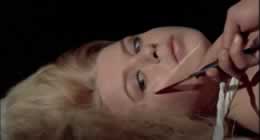 Next up is Malle's "William Wilson," with icy heartthrob Alain Delon starring as the title character, first seen running in a panic into a Catholic confessional booth where he relates the eerie story of his life. Since his childhood days in a military school, William has always been a sadistic bastard prone to dangling his schoolmates in a tub of rats or trying to strangle them in their sleep. However, his efforts are repeatedly thwarted by the presence of his far more moral double, also named William Wilson, who keeps turning up over the years during moments of potentially deadly cruelty. An attempted live dissection of a tied-down nude woman on a surgical table and a twisted game of cards with an Italian beauty named Giuseppina (Bardot, ironically Vadim's previous wife) are just some of Wilson's nastier schemes, but the presence of his doppelganger continues to drive him to the brink of madness.
Next up is Malle's "William Wilson," with icy heartthrob Alain Delon starring as the title character, first seen running in a panic into a Catholic confessional booth where he relates the eerie story of his life. Since his childhood days in a military school, William has always been a sadistic bastard prone to dangling his schoolmates in a tub of rats or trying to strangle them in their sleep. However, his efforts are repeatedly thwarted by the presence of his far more moral double, also named William Wilson, who keeps turning up over the years during moments of potentially deadly cruelty. An attempted live dissection of a tied-down nude woman on a surgical table and a twisted game of cards with an Italian beauty named Giuseppina (Bardot, ironically Vadim's previous wife) are just some of Wilson's nastier schemes, but the presence of his doppelganger continues to drive him to the brink of madness.
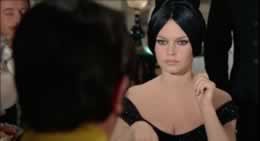 Far less visually opulent than its predecessor, this clinical study of the manifestation of guilt offers some nifty psychological readings, and anyone with a weakness for '60s French cinema will find the chance to see two of its most striking actors working together to be enticement enough. (Too bad Bardot's stuck wearing a really unflattering black wig, but that's easily overlooked.) Delon is excellent here, offering an interesting horror variation on the cold-blooded but magnetic criminals he perfected in films like Le Samourai and The Swimming Pool, and while Malle admits he didn't have much personally invested in this story, the early school scenes are especially potent and serve as a nice warm up for his next narrative feature, the masterpiece Murmur of the Heart. What's especially interesting is the fact that while Vadim's segment got all the criticism for being perverse and unnecessarily sleazy, Malle's is actually far more explicit and shocking. The extended female nudity during the dissection scene, the grisly rat tub, a kinky scene with Bardot stripped to the waist and whipped, and several vivid bursts of bloodshed make this the roughest entry in the film, but Malle's detached approach must have made it palatable enough for general audiences. Still, this was one of the earliest films to earn an R rating under the new MPAA ratings system, and quite deservedly so.
Far less visually opulent than its predecessor, this clinical study of the manifestation of guilt offers some nifty psychological readings, and anyone with a weakness for '60s French cinema will find the chance to see two of its most striking actors working together to be enticement enough. (Too bad Bardot's stuck wearing a really unflattering black wig, but that's easily overlooked.) Delon is excellent here, offering an interesting horror variation on the cold-blooded but magnetic criminals he perfected in films like Le Samourai and The Swimming Pool, and while Malle admits he didn't have much personally invested in this story, the early school scenes are especially potent and serve as a nice warm up for his next narrative feature, the masterpiece Murmur of the Heart. What's especially interesting is the fact that while Vadim's segment got all the criticism for being perverse and unnecessarily sleazy, Malle's is actually far more explicit and shocking. The extended female nudity during the dissection scene, the grisly rat tub, a kinky scene with Bardot stripped to the waist and whipped, and several vivid bursts of bloodshed make this the roughest entry in the film, but Malle's detached approach must have made it palatable enough for general audiences. Still, this was one of the earliest films to earn an R rating under the new MPAA ratings system, and quite deservedly so.
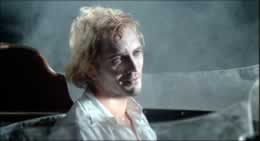 Finally we hit the high point of the film, Fellini's "Toby Dammit, or Never Bet the Devil Your Head." This would be a classic alone on the basis of its magnificent central performance by Terence Stamp, cast here as the title character, a drunken, crumbling wreck of an English actor cast adrift in Rome to star in a spaghetti western with a new Ferrari promised as payment. From his immediate arrival at the airport, he's haunted by appearances of the devil as a creepy young blonde girl clutching a white ball (an image pilfered from Mario Bava's Kill Baby... Kill!), and as he's propelled through a wild gallery of Fellini eccentrics including TV presenters, models, and directors, he becomes more inebriated and detached as the night wears on. When it's finally time to get his cherished Ferrari, Toby embarks on a wild nocturnal ride no viewer will ever forget.
Finally we hit the high point of the film, Fellini's "Toby Dammit, or Never Bet the Devil Your Head." This would be a classic alone on the basis of its magnificent central performance by Terence Stamp, cast here as the title character, a drunken, crumbling wreck of an English actor cast adrift in Rome to star in a spaghetti western with a new Ferrari promised as payment. From his immediate arrival at the airport, he's haunted by appearances of the devil as a creepy young blonde girl clutching a white ball (an image pilfered from Mario Bava's Kill Baby... Kill!), and as he's propelled through a wild gallery of Fellini eccentrics including TV presenters, models, and directors, he becomes more inebriated and detached as the night wears on. When it's finally time to get his cherished Ferrari, Toby embarks on a wild nocturnal ride no viewer will ever forget.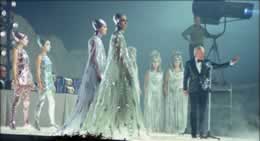
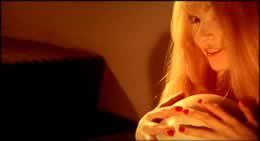 Now things get really complicated. Spirits of the Dead was obviously an international production with an eye on the English language market, and with so many talents involved from different countries, the language issue became very tricky. In America, the film was released by AIP with a new Vincent Price voiceover added at the beginning (a la Conqueror Worm) and three minutes inexplicably trimmed from the Fellini episode to bring the film in safely under two hours. This version was entirely in English, but that's not as simple as it sounds. The Vadim segment was shot in two versions, with Jane Fonda performing most of her close ups in both English and French-- an approach very similar to The Game Is Over, and similarly, she had dubbed her own performance in French for Barbarella, which is thankfully present on Paramount's DVD. However, Peter Fonda only performed his role in English and was dubbed (awkwardly) in the French cut; both versions have their attributes, but overall, the English version of "Metzengerstein" comes out slightly ahead. On the other hand, "William Wilson" was only shot in French, and the dubbed version in AIP's print is just terrible. Then we hit "Toby Dammit;" Stamp only performed his part in English, with the rest of the actors speaking a garbled mix of Italian (without subtitles in the American prints) and heavily accented, usually dubbed English. Much of the film's carnival atmosphere comes from this linguistic chaos, and in the all-French cut, it completely demolishes the entire flavor of the story. Stamp's role only works in English (especially his spotlight Shakespeare soliloquy), and in that respect, the English print easily wins hands down.
Now things get really complicated. Spirits of the Dead was obviously an international production with an eye on the English language market, and with so many talents involved from different countries, the language issue became very tricky. In America, the film was released by AIP with a new Vincent Price voiceover added at the beginning (a la Conqueror Worm) and three minutes inexplicably trimmed from the Fellini episode to bring the film in safely under two hours. This version was entirely in English, but that's not as simple as it sounds. The Vadim segment was shot in two versions, with Jane Fonda performing most of her close ups in both English and French-- an approach very similar to The Game Is Over, and similarly, she had dubbed her own performance in French for Barbarella, which is thankfully present on Paramount's DVD. However, Peter Fonda only performed his role in English and was dubbed (awkwardly) in the French cut; both versions have their attributes, but overall, the English version of "Metzengerstein" comes out slightly ahead. On the other hand, "William Wilson" was only shot in French, and the dubbed version in AIP's print is just terrible. Then we hit "Toby Dammit;" Stamp only performed his part in English, with the rest of the actors speaking a garbled mix of Italian (without subtitles in the American prints) and heavily accented, usually dubbed English. Much of the film's carnival atmosphere comes from this linguistic chaos, and in the all-French cut, it completely demolishes the entire flavor of the story. Stamp's role only works in English (especially his spotlight Shakespeare soliloquy), and in that respect, the English print easily wins hands down.
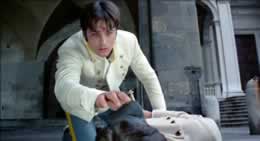 By this point, Fellini fans had given up hope of a good version of one of his greatest achievements ever making it out to the public, but happily, Arrow's 2010 Blu-Ray finally fits the bill. Simply put, if Criterion's 8 1/2 didn't do the trick already, this region-free disc should be enough to get plenty of foreign and horror film fans to make the HD leap. When the disc loads up, you can opt to jump right into the main feature, which plays in the ideal language configuration. "Metzengerstein" is in English, "William Wilson" is French with English subtitles (with the English dub offered as an alternate track), and "Toby Dammit" is English and Italian with English subtitles for the Italian dialogue. You can also watch "Toby" without any subtitles at all (the way it was shown in America), or with English subtitles for all of Stamp's dialogue as well. This is easily the most enjoyable way the film has ever been presented, and it's a huge relief to finally see each director's segment shown on its best behavior. The transfer from the restored original negative is an absolute knockout and easily blows away every other version on the market. The incredible colors from Vadim's segment are finally back to their original luster (check out the blood red on Peter Fonda's wardrobe), Malle's story finally has its original razor-sharp and blue-tinged color scheme intact, and Fellini's bursts to life right from the opening scene with apocalyptic oranges and golds straight out of the same year's Goke, Body Snatcher from Hell. Film grain appears to be natural and intact (the night scenes at the end of "Toby Dammit" don't appear to have been digitally scrubbed to my eyes), and this version bears the opening and closing titles from the English-market release version for Europe under the title Tales of Mystery and Imagination. Also included as a separate extra is the entire French language version of the film in what appears to be a standard def port from the same master used for the prior DVDs; it's vastly inferior in quality but nice to have as an alternate choice, mainly if you want to see how Vadim's segment played with different takes. There's really not much reason to watch it past that point, though. As included is an eye-popping new HD transfer of the great original French trailer; an American trailer also existed at one time (obviously modeled on AIP's trailer for Masque of the Red Death) and can be found (in terrible, dupey quality) on a few ancient fan trailer comps, but its absence here isn't significant at all. Vincent Price's American intro can also be played with the original US credits, which unspooled over the same Poe portrait seen at the end of the original cut. The disc comes with a 60-page booklet containing all three of the original Poe stories (mainly for English lit students who want to be utterly perplexed after watching the film), a "Revisited" essay by Video Watchdog's Tim Lucas, and a Peter Bondanella essay about "Toby Dammit." It's been a long time coming, but at last this often misunderstood, vital work of macabre art is finally available in an edition that can make everyone involved truly proud.
By this point, Fellini fans had given up hope of a good version of one of his greatest achievements ever making it out to the public, but happily, Arrow's 2010 Blu-Ray finally fits the bill. Simply put, if Criterion's 8 1/2 didn't do the trick already, this region-free disc should be enough to get plenty of foreign and horror film fans to make the HD leap. When the disc loads up, you can opt to jump right into the main feature, which plays in the ideal language configuration. "Metzengerstein" is in English, "William Wilson" is French with English subtitles (with the English dub offered as an alternate track), and "Toby Dammit" is English and Italian with English subtitles for the Italian dialogue. You can also watch "Toby" without any subtitles at all (the way it was shown in America), or with English subtitles for all of Stamp's dialogue as well. This is easily the most enjoyable way the film has ever been presented, and it's a huge relief to finally see each director's segment shown on its best behavior. The transfer from the restored original negative is an absolute knockout and easily blows away every other version on the market. The incredible colors from Vadim's segment are finally back to their original luster (check out the blood red on Peter Fonda's wardrobe), Malle's story finally has its original razor-sharp and blue-tinged color scheme intact, and Fellini's bursts to life right from the opening scene with apocalyptic oranges and golds straight out of the same year's Goke, Body Snatcher from Hell. Film grain appears to be natural and intact (the night scenes at the end of "Toby Dammit" don't appear to have been digitally scrubbed to my eyes), and this version bears the opening and closing titles from the English-market release version for Europe under the title Tales of Mystery and Imagination. Also included as a separate extra is the entire French language version of the film in what appears to be a standard def port from the same master used for the prior DVDs; it's vastly inferior in quality but nice to have as an alternate choice, mainly if you want to see how Vadim's segment played with different takes. There's really not much reason to watch it past that point, though. As included is an eye-popping new HD transfer of the great original French trailer; an American trailer also existed at one time (obviously modeled on AIP's trailer for Masque of the Red Death) and can be found (in terrible, dupey quality) on a few ancient fan trailer comps, but its absence here isn't significant at all. Vincent Price's American intro can also be played with the original US credits, which unspooled over the same Poe portrait seen at the end of the original cut. The disc comes with a 60-page booklet containing all three of the original Poe stories (mainly for English lit students who want to be utterly perplexed after watching the film), a "Revisited" essay by Video Watchdog's Tim Lucas, and a Peter Bondanella essay about "Toby Dammit." It's been a long time coming, but at last this often misunderstood, vital work of macabre art is finally available in an edition that can make everyone involved truly proud.
![]()